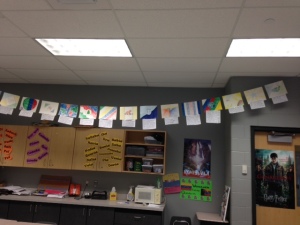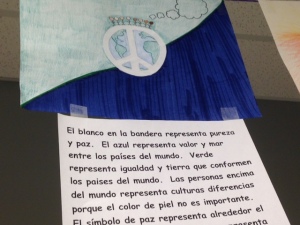 I have written so many times about music and my teaching. I literally have been using music in my classes for the past 37 years! Yes, I know, I’m ancient. What doesn’t ever get ancient is the music. This post is going to be a bit different. I’m trying to consolidate; instead of writing a post about a specific unit I am going to simply list all of my units and the music that anchors each of them. There is NOT ONE unit that doesn’t begin with music, not one. Music is always part of my “hook”. It may not be the only hook, but it always is one of the hooks and the music “plays” on throughout the entire unit.
I have written so many times about music and my teaching. I literally have been using music in my classes for the past 37 years! Yes, I know, I’m ancient. What doesn’t ever get ancient is the music. This post is going to be a bit different. I’m trying to consolidate; instead of writing a post about a specific unit I am going to simply list all of my units and the music that anchors each of them. There is NOT ONE unit that doesn’t begin with music, not one. Music is always part of my “hook”. It may not be the only hook, but it always is one of the hooks and the music “plays” on throughout the entire unit.
Spanish III
- Esperanza, the novel, written by Carol Gaab
- Ave que emigra, Gaby Moreno
- Respira, Luis Fonsi
- Por Amor, Los Tigres del Norte
2. La comida (Puerto Rico), story and unit developed by Sharon Birch
- Vivir mi vida, Marc Anthony
- Te amo, Nota
- El Crisis del restaurantito, Chico Che
3. La ropa, story and unit developed by Sharon Birch and Megan Matthews
- Que me pongo, Mango Punch
- Billy la bufanda, Sr. Wooly
- The Heart wants what it wants (Spanish version of the Selena Gomez song), Kevin, Karla y la Banda My story ended with this expression and song.
4. Robo en la noche, the novel, written by Kristy Placido
- Pura Vida, Percance and Percance, alternate version
- Save the Americans, Costa Rican Animals for the Overworked, Visit Costa Rica Videos
- El Pollito Pio, Pulcino Pio
- Pura Vida, Don Omar
5. Colombia, Juanes y Los Colores de la Montaña, stories and unit developed by Sharon Birch
- A Dios le pido, Juanes
- La Historia de Juan, Juanes
- Segovia, Juanes
- Minas Piedras, Juanes
- Sueño Libertad, Juanes
- Bandera de Manos, Juanes
- Odio por amor, Juanes
- La Tierra, Juanes
- No queremos minas, Yerson y Stuard
- Los Caminos de la vida, Los Diabolitos
6. Bianca Nieves y los siete toritos, the novel, written by Carrie Toth
- Bulería, David Bisbal
- Bamboleo, Gipsy Kings
- Dame Vida, Huecco
Spanish IV
- La Llorona, the novel, written by Katie Baker
- Me equivoqué, CD9
- Me Voy, me voy, Vazquez Sound
- Ay Mazatlán, mi Mazatlán, Mike Laure
- Buenos días, Vazquez Sound
- assorted soccer songs/anthems
2. El Arte (Frida Kahlo, Diego Rivera, Picasso,Dalí), stories and unit developed by Sharon Birch I hope to add the novel, Frida, written by Kristy Placido
- La Llorona,Tributo a Frida, Chavela Vargas
- Más que amor, Il Volo
- Esa noche, Cafe Tacuba
- Salvador Dalí, Mecano
3. La Comida de México y Perú, stories and unit developed by Sharon Birch, original ideas from Kara C. Jacobs and Cristina Zimmerman
- Lupita’s Taco Shop, MC Luka
- La Cumbia del mole, Lila Downs
- Llorando se fue, Cuarteto Continental
- El Cuy mágico, commercial from BCP
- Assorted videos/songs from Inca Kola
- Assorted videos/songs from Ñam Ñam Boys
4. Las Metas y los Sueños, stories and unit developed by Sharon Birch
- Creo en mi, Natalia Jiménez
- Vivir mi vida, Marc Anthony
- Celebra la vida, Axel y Busamante
- No creo en el jamás, Juanes
- No me doy por vencido, Luis Fonsi
- La vida es un viaje, Carreyo
- Siempre Brillarás, Tini (this is new, I will add next year)
5. La Guerra Civil en El Salvador y Voces Inocentes, stories and unit developed by Sharon Birch, original ideas from Kara C. Jacobs
- Casas de cartón, various versions but my favorite is Los Guaraguao; Marco Antonio Solis
- Mi Tierra, Crooked Stilo
- Razones, Bebe
- Mi País, Los Hermanos Flores
6. Vida y Muerte en la Mara Salvatrucha 13, the novel, anonymous
- Gangsta, Kat Dahlia
- Así Crecí, Farruko
- Nada Valgo sin tu amor, Juanes
- Adentro, Calle 13
- Tu cárcel, Enanitos Verdes
- Nuestro Amor, RBD
- Soy Raka, Los Rakas
7. La Inmigración, unit developed by Sharon Birch
- Wake me up, Aloe Blacc
- Ellis Island: The Dream of America, Peter Boyle
- America, Los Tigres del Norte
- ICE, La Santa Cecilia
- Bandera, Aterciopelados
- La Bamba Rebelde, Las Cafeteras
- Pobre Juan, Maná
- Welcome to America, Lecrae
- Pa’l Norte, Calle 13
- American Oxygen, Rihanna
- El Inmigrante, Calibre 50
- Nunca más, La Santa Cecilia
- Tu enemigo, Pablo Lopez y Juanes
8. La Narcoviolencia, unit developed by Sharon Birch, original ideas from Kara C. Jacobs, Cristina Zimmerman and Zachary Jones
- Lágrimas, Camila
- La Patria Madrina, Lila Downs y Juanes
- México, Instituto Mexicano del Sonido
- Bang Bang, Rocca, Tres Coronas
- 43 Lágrimas La Llorona, Subatómicos
- La Señora De Acero, Los Tucanes de Tijuana
- Have you heard, Ceci Bastida
9. Bianca Nieves y los siete toritos, the novel, written by Carrie Toth I taught this in Spanish III and IV this year due to some extenuating circumstances (having to pick up a 6th class in March, no more funding for a new book, etc.) Next year I hope to have the novel Felipe Alou, Carol Gaab, here.
- Bulería, David Bisbal
- Bamboleo, Gipsy Kings
- Granada, Los Tres Tenors
- Quizás, Enrique Iglesias (subjunctive)
- Mi Princesa, Victor Muñoz (subjunctive)




















